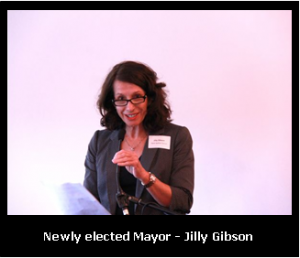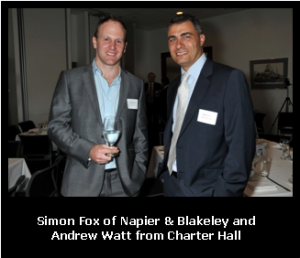 North Sydney’s Jilly Gibson pitching for EUAs, Nightlife & Art
North Sydney’s Jilly Gibson pitching for EUAs, Nightlife & Art
 North Sydney has thrown down the gauntlet to its big sister over the bridge. It’s pitching to be part of
North Sydney has thrown down the gauntlet to its big sister over the bridge. It’s pitching to be part of
the annual Vivid LIVE festival in May and early June. It wants better nightlife and it’s already renamed
a plaza after one of its favourite sons: artist Brett Whiteley.
According to newly elected Mayor Jilly Gibson, North Sydney may soon also have a spate of upgraded and more valuable commercial buildings, thanks to the city’s embrace of the Environmental Upgrade Agreement finance schemes. It wants to have EUA exemplar projects up and running by the end of
this year.
The schemes, which finance environmental upgrades to buildings through energy savings, with repayments managed through charges on local council rates, are spreading rapidly through New South Wales’ local government councils. The City of Sydney launched its first EUA recently with a $26.5 million commitment at the Frasers Property-Sekisui House development at Central Park, Broadway. Parramatta City Council is on board; so is Lake Macquarie and now, North Sydney. Soon joining the program will be Newcastle, Penrith and Wollongong councils.
At a forum last month to introduce EUAs to the local property and business community, co-hosted by the North Sydney Chamber of Commerce, the newly elected mayor was in fine form, underscoring the potential of the area.
The North Sydney region, she said, was working hard to find ways to become a more exciting place – not just for business but for nightlife. The Vivid LIVE festival would be just the start, she promised. “We want to reposition the CBD as both a commercial and [an] entertainment hub.”
As part of this revamp, Mount Street Plaza had already been renamed Brett Whiteley Place in honour of its famous resident painter. And North Sydney will pitch to recruit up to five buildings as champions for its EUA schemes, which are managed by local government because repayments for the programs will be made by charges on council rates.
Gibson said she was delighted that North Sydney was now part of the EUA family and that it could open doors for owners willing to undertake work that would “not only improve the economic efficiency of their buildings, but the bottom line”. Studies have shown that more environmentally efficient buildings attract higher-calibre tenants, longer leases, higher rents and higher property values, Gibson said.
Anthony De Francesco, managing director of IPD, which manages the Property Council of Australia/IPD Australian Green Property Index, presented evidence to back up the Mayor’s position. Green-rated buildings consistently outperformed their non-green counterparts in Melbourne and Sydney, even among their peers in age cohorts, he said in a presentation. The index has been expanded to New Zealand, and again, results are positive for green buildings, De Francesco said. The numbers were clear and were based on a large sample size, which he was happy to “stand by, with a sense of confidence and conviction”.
Steve Hennessy, director of WT Sustainability, kicked off the panel session with his reminder that saving energy is “not a destination, it’s a journey”. Hennessy’s firm, based at offices in Miller Street, North Sydney, deliberately chose to go into a four-star NABERS building. No doubt this was partly because it was a way for the company to show off its energy-saving skills: the offices recently achieved a six-star NABERS energy tenancy rating, before the addition of green power, he noted. “It’s no shock that a poorly performing building will cost more to operate,” Hennessy said. Energy returns may be modest; productivity returns are less so.
Local Government Super property portfolio manager Brian Churchill had more good news on LGS’s outperforming retrofit program, based in Sydney and using mostly Australian technology. “Most of the buildings under our control went up by two NABERS stars and we now average 4.8-star NABERS [ratings] across the portfolio,” Churchill said. Indoor air quality, as measured by NABERS IEQ, also went from 2.5 to 3.5 stars. At 76 Berry Street, North Sydney, LGS commissioned a productivity study by CTEC that reported major lifts in key indicators of building performance, most impressively productivity, which rose by four per cent. When equated to dollars on a square-metre basis, the lift was a massive $188 per square metre, Churchill said. “That’s 10 times your energy savings. So the value to your tenant is not so much the energy but the productivity. “Nothing else was touched: we didn’t do any fit-out work; no furniture, no painting, nothing ¬ – just base building upgrade,” he said.
Consequently, Berry Street tenant satisfaction rose from 66 per cent to 82 per cent; lighting jumped from 67 per cent to 84 per cent; and thermal comfort from 27 per cent to 52 per cent. The point is that, for smaller tenants, this is gold-plated logic. Large corporations have their own benchmarks and hurdles but small businesses are more focused on sheer survival, Churchill contended. A survey LGS conducted with agents and tenant representatives found that only 20 per cent of tenants had a desired sustainability outcome. “So we haven’t sold the proposition well enough,” he said. “Energy savings won’t get people in.” But productivity savings might speak more loudly.
Niall McCarthy, an executive director at Eureka Funds Management, was involved in the EUA for Australian Unity at Parramatta and with the latest EUA for a trigeneration precinct energy system at Central Park Broadway. It could now provide a long-date debt facility for 10 years, fully amortised, McCarthy said.
Grant Nicols, property portfolio manager for Australian Unity, the owner of an EUA undertaken at Parramatta – NSW’s first – touched on the sensitive subject of tenant engagement. EUAs, he contended, could help improve relationships between owners and tenants, in particular because they offered tenants benefits that would not cost them dearly. As distinct from other upgrades that might eventuate in higher rents, EUAs were based on energy savings and paid for out of these savings. The regular tenant/landlord relationship, however, was a fraught one, he noted. “Tenants and landlords only generally meet up to discuss or talk with each other when they’re negotiating the lease or when something goes wrong,” Nicols said. EUAs provided landlords with opportunities to go to tenants at any time, to reinvigorate tenancies and encourage good tenants to stay in their buildings. “You can say, ‘Yes, we can upgrade the building. Yes, you will contribute but it can be at no cost to you – it won’t cost you a cent’. It’s a different conversation to what you usually have.” Environmental upgrades, he noted, were not changes to buildings just to increase rents. EUAs could also demonstrate that landlords can be innovative and flexible in the way they manage buildings. “From our perspective, we’ve got much stronger tenant relationships through entering into the EUA,” he said.
 Napier & Blakely associate director Simon Fox said the initial response from tenants was usually, “What’s the trick?”.
Napier & Blakely associate director Simon Fox said the initial response from tenants was usually, “What’s the trick?”.
“Everyone is risk-averse,” he said. “But the first thing you can say is that the energy savings pay for the upgrade, not the tenant. “The other is that in this market, everyone is risk-averse and [no-one] wants to upset their tenants.”
So pointing out the energy savings that will result from a retrofit will be good news. It’s an ideal way to retrofit lighting and supplementary cooling, and in places such as North Sydney, with its heavy energy use from high-tech businesses, energy savings could be a strong incentive for companies taking on EUAs, Fox said. There’s also the opportunity to bundle cosmetic work with environmental upgrades.
“If you have a cosmetic upgrade and an energy upgrade, you don’t have to look at two separate programs,” he explained. “You can package them up.”
If, for instance, the owners want to upgrade a building’s lobby and toilet but also include an energy-efficiency upgrade, the savings to tenants through lower energy bills than they’d otherwise pay mean tenants also gain. It takes the sting out of any upgrade that leads to an increase in rent.
“What’s the trick? There’s no trick.”
Written by Tina Perinotto
Displayed on the Fifth Estate Website – April 5, 2013
